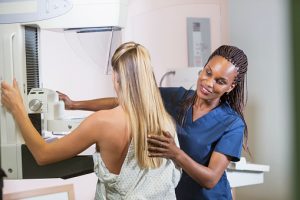Getting a mammogram for the first time can be a bit intimidating, especially if you don’t know what to expect. You may have heard that it’s painful, or you may concerned about exposing yourself to radiation. On the other hand, you may not even know if you need a mammogram at all! Not to worry, we have all the answers you need, for your most frequently asked questions about mammograms.
- What is a mammogram? A mammogram is a type of breast exam that uses noninvasive x-ray technology for the early detection and diagnosis of breast diseases.
- Why have a mammogram? A mammogram can detect lumps in the breast up to two years before they can be felt by a woman or her doctor. Because mammograms allow for early detection, they give doctors the opportunity to treat cancer before it advances to a point that requires extensive treatment.
- How early should I start getting mammograms? This depends on who you ask. Some organizations, like the American College of Radiology, recommend mammograms annually starting at age 40. The American Cancer Society, on the other hand, recommends annual mammograms beginning at age 45. The best way to decide is to talk to your doctor, assess your risk, and determine the age that’s right for you.
- Does the radiation from a mammogram pose a risk to my health? There is always some risk with radiation, but the amount of radiation from a mammogram is very minimal. In fact, a woman is likely to be exposed to as much radiation in the course of seven weeks of normal life as she is during a mammogram.
- How should I prepare for a mammogram? Avoid scheduling your mammogram the week before your period, when your breasts may be tender or swollen. Don’t wear deodorant, lotion, or powder under your arms on the day of your mammogram. You should wear a top and skirt or pants to your appointment rather than a dress, because you’ll be asked to remove your top.
- What’s involved in a mammogram? During a mammogram, the technician will position your breast in a specialized machine that’s designed to look specifically at breast tissue. This machine has two plates that compress the breast, spreading the dense breast tissue to allow for a better picture, using lower radiation. The x-ray moves in an arc over the breast, capturing images from multiple angles, in order to get a complete picture of the breast tissue.
- What does a mammogram feel like? It’s not comfortable to have your breast compressed, but for most women, it’s not painful. If it is painful, tell your technician.
- How long does a mammogram take? The entire process only takes about 20-30 minutes. The breast compression? It only lasts a few seconds per breast.
- What happens if my mammogram is abnormal? Take a breath: an abnormal mammogram does not necessarily mean cancer. It’s likely that your radiologist will want you to come back for further testing, to determine the cause of the anomaly.
- What if my results are normal? Congratulations! Now, continue to get regular screenings. Mammograms work best when your radiologist has more than one to compare. Comparing mammograms is a good way to detect changes in your breasts.
- Where should I go to get a mammogram? It’s best to go to the same facility every time you have a mammogram, so that it’s easier for the doctor to compare your results over time.
For diagnostic, screening, or 3D mammograms, trust Salem Radiology Consultants to provide you with the highest quality of care. A premier outpatient imaging center, Salem Radiology Consultants, or SRC, has been serving Salem and the greater Willamette Valley since 1973. We are the largest radiology group in the area, and our doctors provide a depth of specialization you’d expect to find only at major university medical centers. Call us today at (503) 399-1262 to schedule an appointment.

